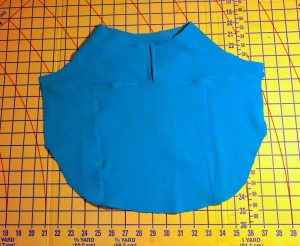Edited to add my new dog who was not here when this post was created. His name is Chico Burrito.
Very soon I will have to figure out how to make three dog shirts for fifty cents!

Okay…back to talking about dog shirts…
Have you seen the prices of clothes for dogs?! Yikes, unbelievable. It may be better to sew clothes for the dog yourself. But oh, have you seen the price of fabric these days?! But there is a solution.
Whether you say thrifty or cheap, or if you call it recycling or upcycling…getting two shirts for the dogs for a grand total of 50 cents seems like quite a bargain. Here is how it can be done.
We first take a trip to the local thrift store where we find a snappy blue sweatshirt in size 5.

We’ll start by assuming that you already have a sewing machine and know how to sew. Also, that you have decent scissors, pins, thread and that you know how to copy a pattern from a shirt that your dog already loves – just trace around the old shirt onto some brown paper. Here is Jack in his favorite red shirt. It fits him perfectly. Jack is too sexy for that shirt.

After running the sweatshirt through the washer/dryer we will prepare to cut away some of the seams. Leave the lower ribbing intact; don’t cut that part. And when cutting off the neck ribbing, leave the seam attached to the neck ribbing; we’ll be using that ribbing later.
Lay sweatshirt flat; prepare to cut away seams.


Here is the fabric ready to be used to make the two shirts.
Lay out the pattern pieces keeping the grainline in mind, pin in place then cut out. Save the scraps; they may be needed later.


This is what’s left of the sweatshirt after all the pattern pieces have been cut for two shirts. There is enough fabric to make half a shirt. All we need is another sweatshirt in a coordinating color but that’s a job for another day.

For the neckline, we will re-use the neck ribbing that we cut from the sweatshirt. Cut the fabric slightly longer than the pattern piece.

On the old red shirt, there was a small opening about the size of a buttonhole meant to be used to attach the leash to the harness. Since I found the hole to be too small for fat fingers, I made a slight design change. Instead of making a buttonhole type opening, I opted for this. And check out what a good color match the thread is.

Here is the same piece which has been assembled with the back and front pieces. 
Okay, since you know how to sew, the rest is easy. Just sew all the seams, try it on to make sure it fits, make adjustments as needed, and that’s it!
Jack loves his new shirt. It is very comfortable.

Uh, oh. Here comes trouble. George wants to see the new shirt. George tries offering a toy to Jack hoping that Jack will give up the shirt. No, that’s not gonna happen. Jack turns his back on George.


Problem solved. I gave George the red shirt to wear and Jack is happy in his new blue shirt.


George doesn’t know how to read yet so he has no idea that the title of this page is “Two Dog Shirts for 50 Cents”. I will make the second shirt and George will be very happy, plus he can keep all his toys.
Hey, I found a great site. Upload your own images to Jigsaw Planet just like this:
https://www.jigsawplanet.com/?rc=play&pid=2fdee15435c0




























 ;
;





